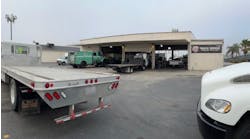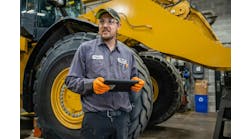Over the past several years, a range of products have been introduced into the marketplace designed to be used inside truck tires for a variety of purposes. These include sealants to prevent losing air pressure; internal balancing materials - such as powders, liquids, gels and/or beads - for ride enhancements; and tire coolants, said to reduce running temperatures.
To help users better identify and understand the potential consequences and concerns associated with these products, the Technology & Maintenance Council (TMC) has developed its Recommended Engineering Practice RP 246, Considerations for Products Intended for Use Inside Tires. This RP also offers evaluation guidelines for the selection of materials intended for use inside truck tires.
RP 246 applies to products designed for use inside the contained air cavity of tubeless radial truck tire/wheel assemblies on commercial vehicles with a gross vehicle weight rating of more than 10,000 pounds.
RECOMMENDED PRACTICES
A technical council of American Trucking Associations (ATA) – the largest national trade association for the trucking industry, TMC is North America’s premier technical society for truck equipment technology and maintenance professionals.
TMC Recommended Practices (RPs) are specifications or practices to assist equipment users, vehicle and component manufacturers and other industry suppliers. There are two types, the adoption of which, is voluntary.
Recommended Maintenance Practices are concerned with the maintenance of commercial vehicle equipment, and also include informational documents that cover technical aspects of maintenance, equipment and supporting technologies.
Recommended Engineering Practices pertain to the design, specification, construction and performance of commercial vehicle equipment.
PRODUCT TYPES
“Before selecting a product for use inside tires, it is important to obtain accurate information about what benefits a product of this type can and cannot deliver, as well as any effects it may have on tire mounting and other maintenance practices,” states the RP 246. “Accordingly, TMC recommends obtaining results for comparison from experienced users with similar service conditions and equipment.
“Since these materials will be in constant contact with both tire and wheel interior surfaces, issues such as chemical compatibility, abrasion resistance, corrosion and possible material changes must be considered for tire, wheel, valve and other components.”
Basically, there are three general categories of products for us inside truck tires, TMC says.
1. Sealants - These are intended to slow inflation loss caused by small punctures and bead leaks in both tubeless and tube tires. Historically, notes TMC, sealants have been “used in mixed service or off-road applications where tires are subjected to penetrations, cuts or other hazards that can cause loss of inflation pressure, especially in conditions that make immediate or in-route repairs difficult or dangerous.”
Sealants vary in composition, typically being either liquid, a liquid with suspended solids, semi-solid or gel.
2. Balancing and ride improvement materials - These are designed to replace traditional, external balance weights. When installed, the material - typically in the form of a powder, liquid or tiny beads - is intended to distribute itself on the balance requirements of the individual tire as the load and speed changes, making the tire self-balancing.
3. Coolants - These are meant to reduce the running temperatures of tires so as to help increase tire durability and tread life.
ASSESSMENT ISSUES
TMC’s Recommended Practice RP 246 does not get into determining the validity of performance claims for the different brands and types of tire additives. It does, however, provide a number of questions that potential users of these products would be well-advised to ask any prospective suppliers.
Among the questions:
- What specific performance claims does the product manufacturer make? If more than one claim is made, says TMC, how likely is it that the product will be equally effective as a sealant, ride improvement, coolant, etc.
- Is the product chemically compatible with the tire, wheel, paint, surface coatings, valve hardware and other tire/wheel components that it will contact in normal use?
- How does the product change with time and use?
- Is the material restricted to any specific vocations or service conditions?
- How does the product impact tire mounting/demounting, casing inspection procedures, repairing, retreading and other routine tire/wheel service?
- Is the product compatible with other materials being used in the tire/wheel mounting and maintenance process?
- Are there considerations for removal and disposal of the product?
- How long has the material been used in the industry, and can the prospective vendor furnish user references?
- Is a material safety data sheet (MSDS) supplied with the product?
- Are there any toxic material issues to consider when disposing of the product?
- Are reputable test lab results available that document product performance?
- Will the product have any effect on warranty consideration for tire, wheel or other related components?
- - Is the material compatible with tire pressure monitoring system (TPMS) sensors the fleet is using?
The Recommended Engineering Practice RP 246, Considerations for Products Intended for Use Inside Tires, will be officially published this spring with publication of TMC’s 2011 Recommended Practice Manual Supplement.
TIRE DEVELOPMENTS
While companies are continuing development of products for uses inside truck tires, truck tire manufacturers are continuing with their innovation and advances in tire technology. Here is what some of tire manufacturers are doing.
YOKOHAMA
Yokohama Tire Corporation’s latest tire technology is the Zenvironment philosophy, says Rick Phillips, director of commercial sales. It focuses on four components: casing design, rubber compound, tread design and manufacturing process.
“Casing design is the foundation all our products start with,” he says. “We utilize a technology called finite element analysis (FEA), where we divide the tire into several thousand tiny individual sections or elements. Each element is analyzed under simulated operating conditions.”
This allows Yokohama engineers to accurately predict physical changes the tire will undergo during its lifetime. By doing so, the company can “reduce the strain to the casing from normal stress or applied force, says Phillips. The result is cooler operating temperatures and greater casing life and retreadability.
“We have developed a one-step mixing process that eliminates most of the heat generation and stress of a typical four-step mixing process. The result is a more consistent compound that has better performance properties such as traction and fuel efficiency.”
The tread design contains elements relative to the application, says Phillips. The various combinations of different tread elements, such as sipes, stress control ribs and even actual tread depth and width, all contribute to make a product that’s better suited for its intended application. These tread features are all established in the FEA stage.
Once all the material components are decided, the tire is then manufactured. All Zenvironment tires are manufactured to a very specific and high standard, in a process that is completely environmentally-friendly.
“The Zenvironment philosophy has resulted in the most technologically-advanced products we have ever produced,” Phillips notes.
MICHELIN
Michelin has long been an innovator in the tire industry, and specifically in the trucking industry, with the introduction of dual tires, radial tires and new generation wide single truck tires, says Don Baldwin, product manager, Michelin Americas Truck Tires. Michelin Americas Truck tires has made steady improvements across all performance parameters including, tread wear, traction, rolling resistance and retreadability.
“This continuous progress has been punctuated through new product introductions in all segments and the introduction of some key technologies that continue to form the basis for new technologies and breakthroughs,” he says. Four pivotal technologies are: Matrix Siping Technology, Regenerating Tread, Advanced Technology compounding and Infini-Coil Technology.
- Matrix Siping Technology is a three-dimensional technology and makes the tread block more rigid, reducing tread wear, yet delivering needed traction through biting lateral edges, explains Baldwin. By locking together to resist horizontal and vertical stresses, the Matrix sipes offer longer life than traditional siped tread patterns.
“This tread design feature also delivers improved grip on snow, ice and wet surfaces, and allows for increased density of the sipes without compromising tread block rigidity, stability and wear.”
- Regenerating Tread is a tread design that “allows new features to be revealed as the tread wears, thereby providing additional traction later in life and extending the working life of the tire’s original tread,” he says.
- Michelin’s X One wide single tire is made possible by Infini-Coil Technology - more than a quarter-of-a-mile of steel cord wrapped circumferentially around the crown of each tire. This technology reduces casing growth and stabilizes the contact patch, reducing irregular wear.
- Advanced Technology compounding allows the company “to very finely tune the volume and profile of two or more unique rubber mixes to deliver a seamless single semi-finished component in the tire making process,” Baldwin says. This technology is used in not only the tread area but also the sidewall rubber.
In terms of tread rubber, the compounding “enables the most robust, highest-performing compounds to be used for the tire/road interface, while using cooler running compounds to form a precisely contoured lower layer to protect the casing from excess heat in some cases - helping retreadability - and further reducing rolling resistance levels in others.
“As for the future of tire technology and tire trends, Baldwin says “fuel efficiency will continue to be a key performance requirement from fleets and owner/operators.”
HANKOOK
Hankook Tire’s development engineers are developing new technologies and design strategies to address the need for low rolling resistance tires while retaining other important performance characteristics, says Clinton Covey, truck, bus and RV a development engineer with the company.
“Low rolling resistance tires deliver a significant improvement in fuel mileage, he goes on. “A 3 percent reduction in rolling resistance translates to approximately 1 percent in fuel savings.
“Trucks fitted with low rolling resistance tires may see anywhere from a 1 to 10 percent and upwards savings in fuel, dependent on the tires which were replaced. This means different tires may have rolling resistance performances varying by 30 percent or more.”
Wide-base tires, low rolling resistance compounds and improved manufacturing processes are successfully decreasing the rolling resistance of specific tire makes and models, says Covey.
A tire’s tread rubber accounts for a substantial portion of its mass and typically contributes 35 to 50 percent to rolling resistance, he notes. Therefore, the use of low rolling resistance tread compounds can significantly improve the rolling resistance performance of a tire.
Not only does tread rubber account for a generous portion of a tire’s contribution to fuel economy, it also greatly influences tread wear and traction. “New tread compound development technologies are greatly improving rolling resistance while retaining excellent tread wear, traction and other important performance characteristics.”
Tire manufacturing processes, particularly curing, can be altered to affect certain tire characteristics, including rolling resistance, he explains. The two main manufacturing processes are the assembly of the “green” tire and the curing process.
During green tire assembly, components are wrapped in a particular order around a metal cylinder, forming the composite green tire. This green tire is then inserted into the mold and heated to a high temperature for a certain amount of time, determining the final shape of the tire to include tread pattern and sidewall markings.
“The most significant variables during the curing process are total time in the mold, and the temperature at which the tire is cured at any given time. Varying these parameters appropriately can significantly affect the performance properties of the tire, including improved rolling resistance, he says.
“Advanced finite element analysis modeling aids engineers in making more accurate predictions as to how changes in tire construction will benefit rolling resistance performance. Computer simulation enables the engineer to make changes in cavity shape, component geometry, compounds and other parameters to predict performance through a variety of conditions. Design candidates are compared using this information, leading to a tire optimally designed for rolling resistance and other important performance criteria.
“These tools effectively aid the development process, decreasing development time, saving costs and improving results.”
Trucks having trailer and drive positions fitted with wide-based tires can experience a 1 percent to 10 percent improvement in fuel economy, dependent on the tire models replaced, he says.
The creation of new tire designs, improvements in compounds, advanced manufacturing processes and computer aided analysis, will lead to the production of even more fuel efficient low rolling resistance tires, he concludes. “Through these new technologies, tire manufacturers will continually improve product performance to meet fleets’ fuel savings requirements in order to operate more efficiently, environmentally friendly and economically.”
CONTINENTAL
Continental Tire the Americas has just introduced a new bead technology for waste haul tires and other severe service applications with heavy front axle loads.
Roger Stansbie, Continental’s director of radial truck tire engineering, says the new I-Stable bead features an 18 percent increase in chafer cord density; an increase in the amount of tear-resistant wrap at the chafer and ply edges of the steel cord; an optimized chafer angle for improved stiffness across the body ply of the tire; and an extruded sidewall, turn-up cover and rim strip.
“The new bead design results in greater stability, extended tire life and, most importantly for this segment, greater potential for retreading,” he says.
Tires in this segment, especially those for waste haulers, may only have an original lifetime of a few months because of frequent curbing, cuts, chips and other damage, says Stansbie. The new I-Stable “bead not only supports heavy loads, but can help protect the sidewall so that the tire has the potential for multiple retreads - resulting in cost efficiency.”




